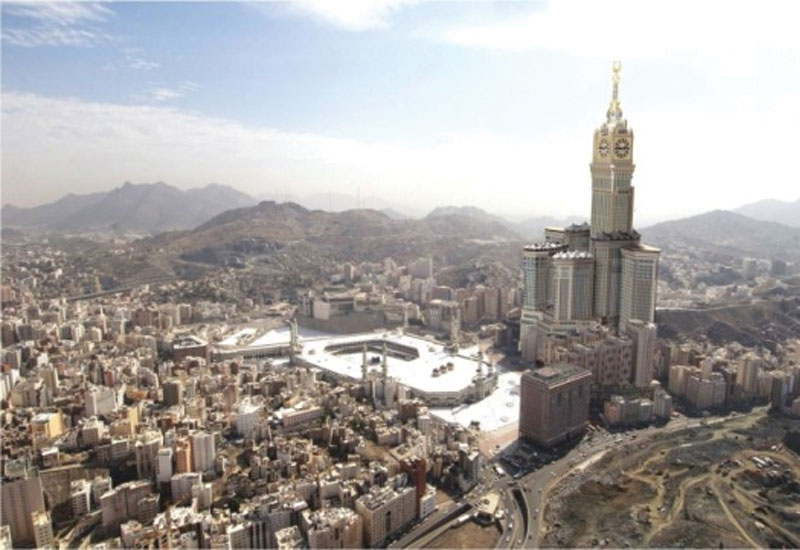 Located adjacent to the Masjid al Haram, Makkah Clock Royal Tower, A Fairmont Hotel stands 76-storeys tall and features a 40-metre Royal Clock, visibl
Located adjacent to the Masjid al Haram, Makkah Clock Royal Tower, A Fairmont Hotel stands 76-storeys tall and features a 40-metre Royal Clock, visibl
With a predicted increase in visitors over the next four years, and hotel chains clamouring for a piece of the pie, Saudi Arabia’s tourism industry is set to boom says Harriet Sinclair
The Kingdom of Saudi Arabia has long been a draw for religious tourists visiting the holy cities of Makkah and Madinah; but with the number of hotels in these cities on the rise, and a predicated increase in the number of both business and leisure travellers, tourism in Saudi Arabia is set to boom.
During 2009 the number of business travellers to the Kingdom stood at 3.96 million, while leisure travellers accounted for 13 million visitors. However, these figures are to be dwarfed over the next four years, according to global information publisher Euromonitor International — which forecasts business arrivals for 2014 of 7.5 million and puts leisure arrivals at a staggering 22.7 million visitors.
According to Jones Lang LaSalle Hotels senior vice president Chiheb Ben-Mahmoud, the Saudi Arabian market is characterised by two factors — the large size of the domestic tourist market, and the importance of Hajj and Umrah.
“Domestic tourism plays an essential role in the Saudi Arabian hospitality sector,” explains Ben-Mahmoud.
“As of 2009, there were 33.5 million domestic visitors’ trips taken within Saudi Arabia. Of these trips, almost 32 million were tourist overnight trips, generating 198.5 million room nights. With the impressive efforts of the SCTA in promoting domestic tourism, these numbers are bound to grow and will have an impact on hotel occupancy rates, albeit in school holiday periods.”
“In 2009, there were 10.9 million international tourist (overnight) trips to the Kingdom of Saudi Arabia; of these 47% were for Hajj and Umrah purposes (5.1 million arrivals out of a total 8.3 million Hajj and Umrah visitors, the difference being the 3.2 million of Hajj and Umrah pilgrims from Saudi Arabia).”

Advertisement
It is these two unique factors which make the Saudi Arabian market one of the most complex settings, Ben–Mahmoud stresses, as both segments are in transition and are driven by different forces — domestic tourism is emerging and demand moving to higher quality standards, while Hajj and Umrah figures are more governed by government imposed regulations, due to the strategy of upgrading the infrastructure and addressing the safety and security needs.
The increasing number of visitors may go some way towards explaining the attraction Saudi Arabia holds for hoteliers. With business arrivals potentially doubling over the next four years, and leisure arrivals increasing by almost 10,000 visitors, there is ample opportunity for brands to enter the KSA market over the coming years.
“There are opportunities in Saudi Arabia because the number of international hotels is still somehow limited, so opportunities are there,” explains Rosewood Corniche managing director Hans Peter Leitzke.
“One of the reasons for our growth in a sense is that a pretty large number of our guests are actually coming from within the Kingdom; we actually have a lot of traffic between Riyadh and Jeddah and vice versa, so the feeder market or the traffic is within, and this helps to sustain a certain level of occupancy,” he adds.
Internal travel is an important aspect of the Saudi Arabian market, as many Saudi Nationals choose to take holidays in KSA, as well as travelling to the holy cities for Hajj and Umrah, asserts Michel Noblet, chief executive officer of HMH — which is opening a number of hotels in the country in the next two years.
“The strength of Saudi Arabia is that it is the biggest market in the Gulf, so they rely on the domestic market and the domestic market is very powerful so all the cities in the Kingdom, let’s say they develop good business. It’s like India – the strength is the domestic market. They don’t depend on international visitors,” he explains.
Jeff Strachan, vice president sales and marketing, Middle East and Africa, Marriott International, adds: “The Saudi Arabia market will continue to grow exponentially over the next few years. Let us not forget that the population growth within the Kingdom is enormous and, therefore, you will start to see the quick emergence of secondary cities and also suburban areas around the major cities”.
These locations and their demand generators are perfectly suited to Marriott’s Residence Inn brand, which is set to enter the Middle East at Jizan on the Red Sea in 2012, Strachan explains.








 Search our database of more than 2,700 industry companies
Search our database of more than 2,700 industry companies









